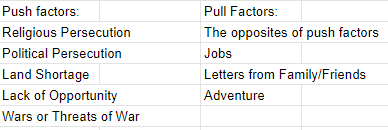Immigration Test Packet
5.0(2)
5.0(2)
Card Sorting
1/21
Earn XP
Description and Tags
Study Analytics
Name | Mastery | Learn | Test | Matching | Spaced |
|---|
No study sessions yet.
22 Terms
1
New cards
Explain an immigrant's journey to America in detail.
They first traveled by wagon or train to a port city. Most immigrants traveled in the steerage of ships for 12 days. It was crowded, cold, wet, dangerous (theft and shaking), dark, sickening (seasickness from rocking), and very stinky. They then got interrogated with obscure questions and had medical inspections done before waiting in line for days to finally get their names changed and enter America. yay...
2
New cards
What famous landmark located in New York Harbor greeted immigrants arriving on the East Coast?
The Statue of Liberty
3
New cards
Explain what you think is meant by the words written by Emma Lazarus.
Explain it. The words were “Give me your tired, your poor, your huddled masses yearning to breathe free, the wretched refuse of your teeming shore. Send these, the homeless, tempest-tossed to me, I lift my lamp beside the golden door!”.
4
New cards
What was the reason that some processors changed the immigrant's names?
There were many reasons. Most of the time it was because their names were too long or hard to pronounce for Americans which would cause inconvenience in daily life. Sometimes, the man behind the desk was just lazy. Slobodan Milošević? Nope, your Slobo Mozo now.
5
New cards
Who were the nativists? What were the nativist attitudes towards the immigrants? Explain why they had these feelings towards the immigrants.
Americans who opposed immigrants for the following reasons. Source: Wikipedia.

6
New cards
Describe the conditions inside a sweatshop.
"a factory or workshop, especially in the clothing industry, where manual workers are employed at very low wages for long hours and under [dangerous and unsanitary] conditions."
7
New cards
Define emigrate.
to move from one country to another - Mr. Bermudez
8
New cards
Reasons for immigrants to come to America.
Image feels more comfortable to look at. Forgot to add public education as pull factor.

9
New cards
Slums
Ethnic communities/neighborhoods. Examples include Germantown, Little Cuba, Chinatown, Little Italy, etc.
10
New cards
Gentleman's Agreement
"Gentlemen's Agreement, (1907-1924), U.S.-Japanese understanding in which Japan agreed not to issue passports to emigrants to the United States, except to certain categories of business and professional men."
11
New cards
Immigration Act of 1917
"Bans Asians, Other Non-White People from Entering U.S." "The 1917 Asian exclusions did not apply to those working in certain professional occupations and their immediate families" such as teachers, students, lawyers. It also excluded "travelers for curiosity or pleasure". It ended in 1952.
12
New cards
Where did the middle class start to move to at this time? Why?
They moved to the suburbs for living because of the pollution, crime, and corruption in the urban areas. Many still went for work during the day.
13
New cards
Define urban.
"in, relating to, or characteristic of a town or city."
14
New cards
Define rural
"in, relating to, or characteristic of the countryside rather than the town."
15
New cards
Define regionalism
"works that describe a distinctive local geography and culture" characters, dialect, customs, landscapes, etc.
16
New cards
Define realism
"a literary movement that represents reality by portraying mundane, everyday experiences as they are in real life."
17
New cards
Why do you think these writing styles were popular at the time?
Americans could relate to what they were going through.
18
New cards
Define yellow journalism. Which two men used this style of journalism to sell their newspaper?
"journalism that is based upon sensationalism and crude exaggeration." William Randolph Hearst and Joseph Pulitzer.
19
New cards
Define vaudeville and provide a modern example.
"1 : a light often comic theatrical piece frequently combining pantomime, dialogue, dancing, and song 2 : stage entertainment consisting of various acts (such as performing animals, comedians, or singers)"
Modern day: America's Got Talent
Modern day: America's Got Talent
20
New cards
Why were immigrants deported back to their home country?
Suspicion of disease, crime, or bad intentions. - Me. Fact check if needed.
21
New cards
Rapid ________ and urbanization led to overcrowded immigrant neighborhoods and overcrowded _________ homes.
immigration; tenement. (Kind of obvious but it was on study guide)
22
New cards
Highly discriminated groups.
Chinese, Japanese, and Irish.